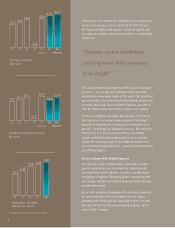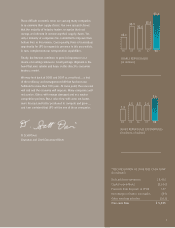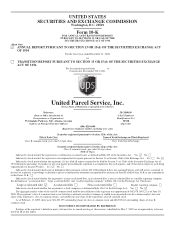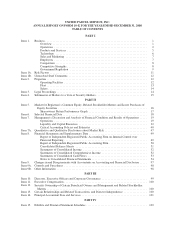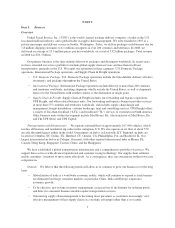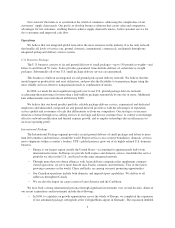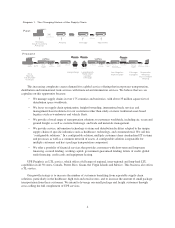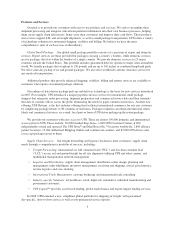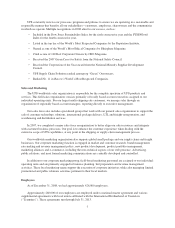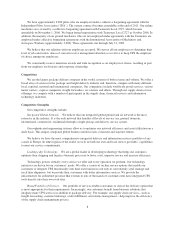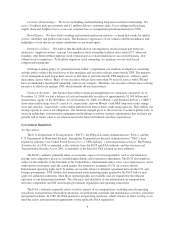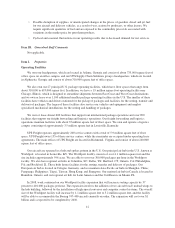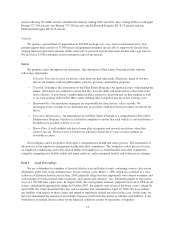UPS 2008 Annual Report Download - page 17
Download and view the complete annual report
Please find page 17 of the 2008 UPS annual report below. You can navigate through the pages in the report by either clicking on the pages listed below, or by using the keyword search tool below to find specific information within the annual report.Freight Services. UPS Freight provides LTL services through a network of owned and leased service
centers and carrier partnerships. UPS Freight also provides our customers with truckload and dedicated truckload
transportation solutions. Since expanding into the freight transport market, we have enhanced our value
proposition through improvements in technology, operations and the customer experience. In 2007, we integrated
all freight products, into our small package visibility systems, enabling shippers to view the status of package and
freight shipments from a single web page. Since mid-2007, UPS Freight has accelerated transit times on over
12,000 lanes. Significant service and reliability improvements for freight transportation enabled us to implement
a no-fee, guaranteed delivery service in early 2008 and expand it to Canadian deliveries later in the year.
Technology
Technology is the backbone of everything we do at UPS. It is at the heart of customer access to the
company.
•UPS.com processes over 18 million package tracking transactions daily. A growing number of those
tracking requests now come from customers in countries that have wireless access to UPS tracking
information.
• Package tracking, pickup requests, rate quotes, account opening, wireless registration, drop-off locator,
transit times and supply ordering services are all available at customers’ desktops or laptops. The site
also displays full domestic and international service information and allows customers to process
outbound shipments as well as return labels for their customers.
• Businesses in a number of countries also can download UPS OnLine Tools SM to their own websites
for direct use by their customers. This allows users to access the information they need without leaving
our customers’ websites.
• In 2007, we integrated all freight products, including international air freight forwarding shipments,
into our small package visibility systems. Now a shipper can view the status of package and freight
shipments from a single web page.
Technology is also the foundation for process improvements within UPS that enhance productivity, improve
efficiency and reduce costs. The most comprehensive improvement to our U.S. small package handling facilities
was completed in 2007. This multi-year effort re-engineered our domestic business, based on a data-driven
platform, and included software, hardware and process changes. It enables a package center to produce an
optimized dispatch plan for every driver and detailed loading instructions for every vehicle before center
employees handle any packages. This plan reduces mileage driven, resulting in substantial savings in fuel usage.
The re-engineered system provides the basis for unique customer-focused services based on the customer-
specific data which powers the system.
In 2008, we began deploying Telematics, a technology that combines information from our drivers’ hand-
held computers with GPS and automotive sensors to help us better manage our ground fleet operations. It will
help us to improve vehicle maintenance, enhance safety and fine-tune delivery and pick-up service. This
technology will also help us improve on-road performance by reducing vehicle expense, fuel consumption, and
carbon emissions. In 2008, we equipped 3,226 of our U.S. vehicles with the sensors needed to achieve the
benefits from this technology.
Sustainability
UPS takes seriously its commitment to operate in a socially, environmentally and economically sustainable
manner. In 2003, the company was the first in its industry to publish a sustainability report that set forth its five-
year goals – and then to provide annual updates on progress toward attaining those goals. The website
sustainability.ups.com provides complete information on these efforts.
6


